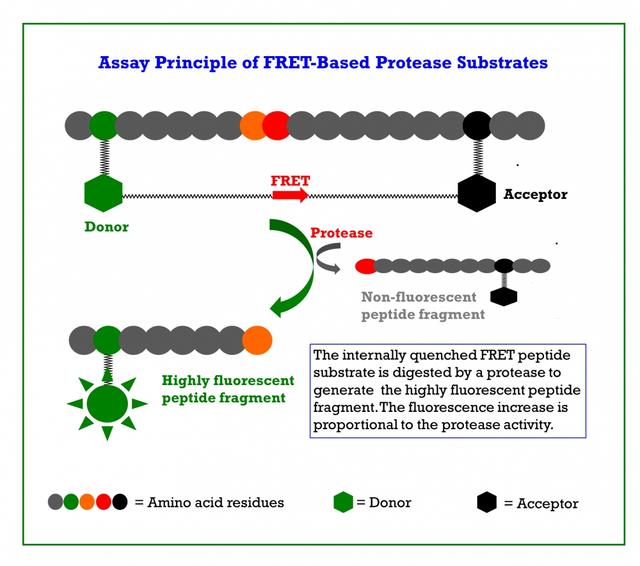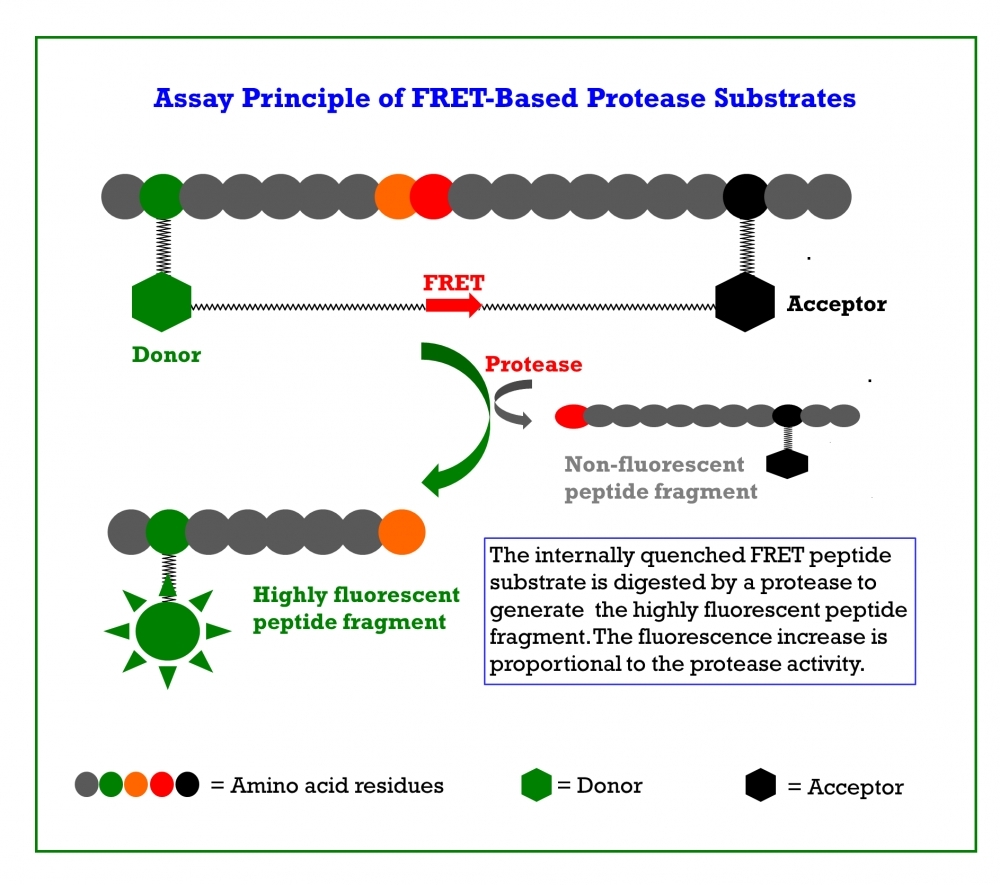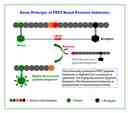Covidyte™ IF670
Coronaviruses (CoVs) can infect humans and multiple species of animals, causing a wide spectrum of diseases. In late 2019, a novel coronavirus, termed severe acute respiratory syndrome coronavirus 2 (SARS-CoV-2) was determined as a cause for several cases of respiratory disease (Covid-19). The virus rapidly spread worldwide. As of May 31st, 2022, more than 6.2 million people have died from coronavirus worldwide, and ~530 million cases have been reported. Currently, there are not any specific and effective options available for treating Covid-19. At present the clinical treatment of Covid-19 is mainly symptomatic combined with repurposing of already marketed antiviral drugs such as Remdesivir and antibiotics to treat secondary infections. There is an extremely urgent need for the development of specific antiviral therapeutics and vaccines against SARS-CoV-2. The coronavirus main protease, which plays a pivotal role in viral gene expression and replication through the proteolytic processing of replicase polyproteins, is an attractive target for anti-CoV drug design. The inhibition of viral proteases necessary for proteolytic processing of polyproteins has been a successful strategy in the treatment of human immunodeficiency virus (HIV) and hepatitis C respectively, proving the potential of protease inhibitors for the treatment of viral infections. Similarly, the main protease of SARS-CoV-2 is thought to be essential for viral replication and, therefore, is regarded as promising target for antiviral therapy of Covid-19. Covidyte™ IF670 is a peptide substrate containing 12 amino acid sequence (VNSTLQSGLRKM) that can be cleaved by coronavirus proteases. The dark-FRET peptide contains Tide Quencher™ 5 (TQ5) as a quencher and iFluor® 670 as a fluorescent donor on the N-and C-terminals respectively where the fluorescence of iFluor® 670 is effectively quenched by TQ5 when the peptide is intact. When the peptide is hydrolyzed by coronavirus proteases, the iFluor® 670 fragment generates significantly enhanced fluorescence since its fluorescence is no longer quenched by TQ5. The activity of coronavirus proteases can be effectively monitored by the fluorescence intensity of iFluor® 670. Covidyte™ IF670 is a robust high throughput screening tool for searching inhibitors of coronavirus proteases. Comparing to the commonly used EDANS substrates (such as Covidyte™ ED450), the iFluor® 670 substrate has much stronger and longer fluorescence that is less interfered by colored compounds that often cause false positive hits.
Example protocol
PREPARATION OF STOCK SOLUTIONS
Unless otherwise noted, all unused stock solutions should be divided into single-use aliquots and stored at -20 °C after preparation. Avoid repeated freeze-thaw cycles.
Note Make single use aliquots and store at -20 °C.
Covidyte™ IF670 stock solution (200X)
Add 25 µL (For cat# 13542) or 250 µL (For cat# 13543) DMSO to Covidyte™ IF670 vial.Note Make single use aliquots and store at -20 °C.
PREPARATION OF WORKING SOLUTION
1. Covidyte™ IF670 working solution
Dilute substrate stock solution at 1:200 in 20 mM Tris buffer (pH 7.5) or buffer of your choice. Use 50 μL of substrate solution per assay in a 96-well plate.2. Coronavirus proteases dilution
Dilute the coronavirus proteases as desired.SAMPLE EXPERIMENTAL PROTOCOL
Sample Protocol for One 96-well plate
- Add 50 μL of EACH protease dilution to respective wells of the assay plate.
- Add 50 μL of Covidyte™ IF670 working solution to each protease dilution.
- Monitor the fluorescence increase with a fluorescence plate reader at Ex/Em = 640/680 nm (cutoff 660 nm).
For end-point reading: Incubate the reaction at a desired temperature for 30 to 120 minutes, protected from light. Then measure the fluorescence intensity.
Spectrum
Product family
| Name | Excitation (nm) | Emission (nm) | Extinction coefficient (cm -1 M -1) | Correction Factor (280 nm) |
| Covidyte™ ED450 | 336 | 455 | 5900 | 0.107 |
| Covidyte™ EN450 | 336 | 455 | 5900 | 0.107 |
| Covidyte™ TF670 | 649 | 663 | 250000 | 0.027 |
Citations
View all 1 citations: Citation Explorer
Rational design of a new class of protease inhibitors for the potential treatment of coronavirus diseases
Authors: Westberg, Michael and Su, Yichi and Zou, Xinzhi and Ning, Lin and Hurst, Brett and Tarbet, Bart and Lin, Michael Z
Journal: bioRxiv (2020)
Authors: Westberg, Michael and Su, Yichi and Zou, Xinzhi and Ning, Lin and Hurst, Brett and Tarbet, Bart and Lin, Michael Z
Journal: bioRxiv (2020)
References
View all 50 references: Citation Explorer
Structural and biochemical characterization of SADS-CoV papain-like protease 2.
Authors: Wang, Lu and Hu, Weihua and Fan, Chengpeng
Journal: Protein science : a publication of the Protein Society (2020): 1228-1241
Authors: Wang, Lu and Hu, Weihua and Fan, Chengpeng
Journal: Protein science : a publication of the Protein Society (2020): 1228-1241
Prediction of the SARS-CoV-2 (2019-nCoV) 3C-like protease (3CL pro) structure: virtual screening reveals velpatasvir, ledipasvir, and other drug repurposing candidates.
Authors: Chen, Yu Wai and Yiu, Chin-Pang Bennu and Wong, Kwok-Yin
Journal: F1000Research (2020): 129
Authors: Chen, Yu Wai and Yiu, Chin-Pang Bennu and Wong, Kwok-Yin
Journal: F1000Research (2020): 129
Potential inhibitors against 2019-nCoV coronavirus M protease from clinically approved medicines.
Authors: Liu, Xin and Wang, Xiu-Jie
Journal: Journal of genetics and genomics = Yi chuan xue bao (2020)
Authors: Liu, Xin and Wang, Xiu-Jie
Journal: Journal of genetics and genomics = Yi chuan xue bao (2020)
Unrevealing sequence and structural features of novel coronavirus using in silico approaches: The main protease as molecular target.
Authors: Ortega, Joseph Thomas and Serrano, Maria Luisa and Pujol, Flor Helene and Rangel, Hector Rafael
Journal: EXCLI journal (2020): 400-409
Authors: Ortega, Joseph Thomas and Serrano, Maria Luisa and Pujol, Flor Helene and Rangel, Hector Rafael
Journal: EXCLI journal (2020): 400-409
In silico and in vitro analysis of small molecules and natural compounds targeting the 3CL protease of feline infectious peritonitis virus.
Authors: Theerawatanasirikul, Sirin and Kuo, Chih Jung and Phetcharat, Nanthawan and Lekcharoensuk, Porntippa
Journal: Antiviral research (2020): 104697
Authors: Theerawatanasirikul, Sirin and Kuo, Chih Jung and Phetcharat, Nanthawan and Lekcharoensuk, Porntippa
Journal: Antiviral research (2020): 104697
Page updated on August 14, 2025




